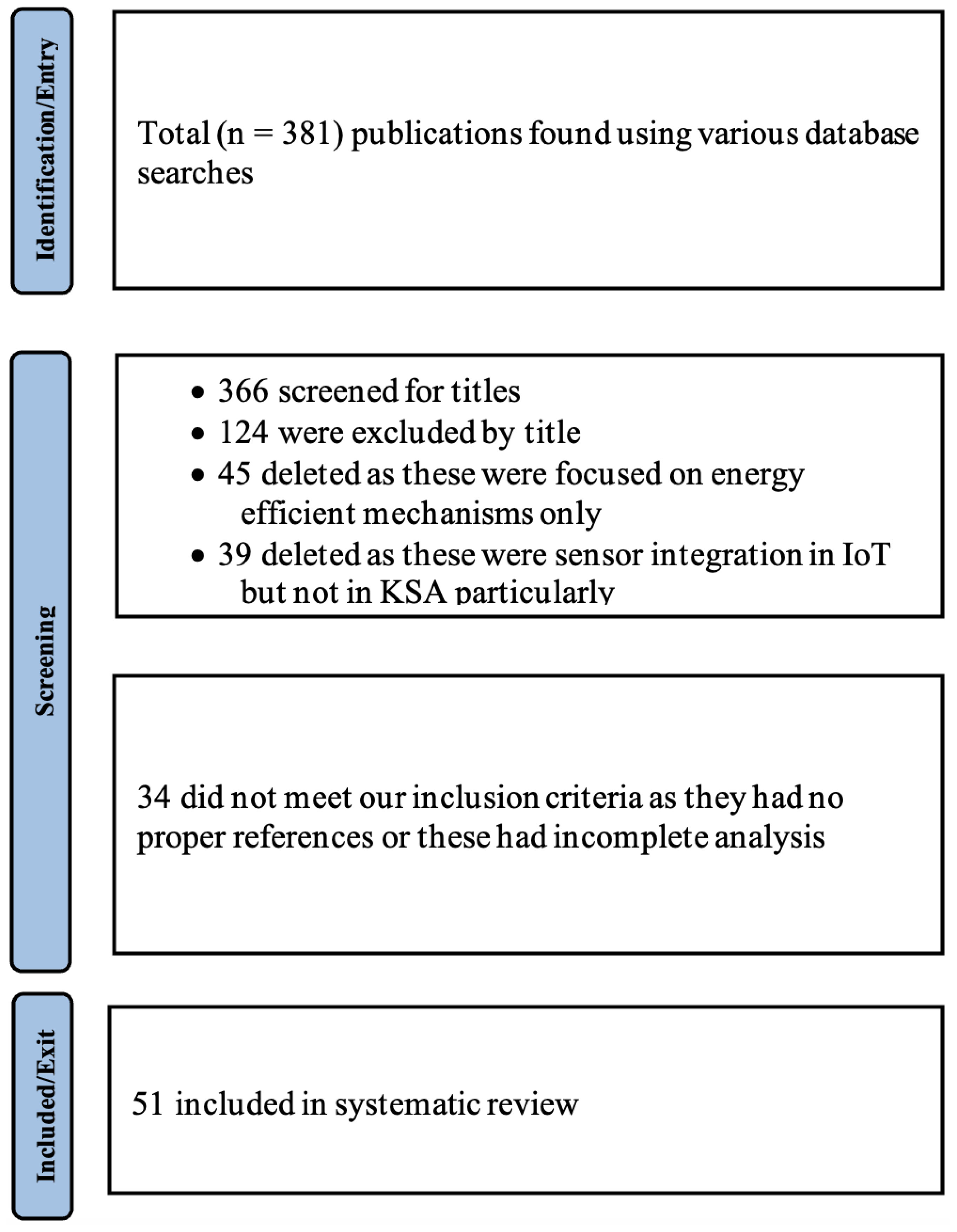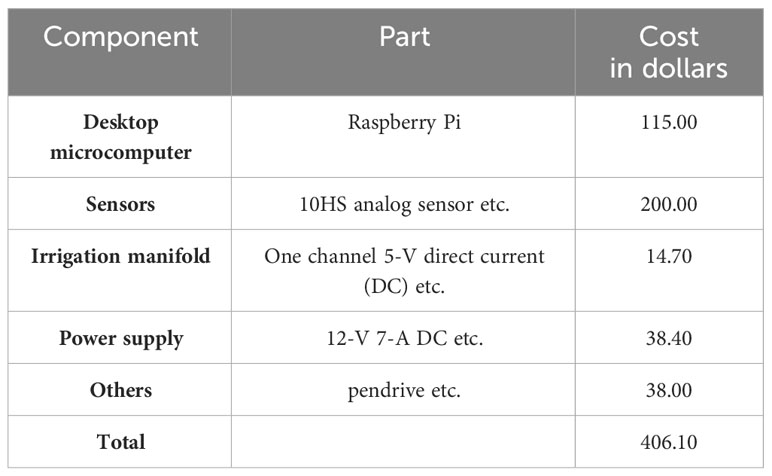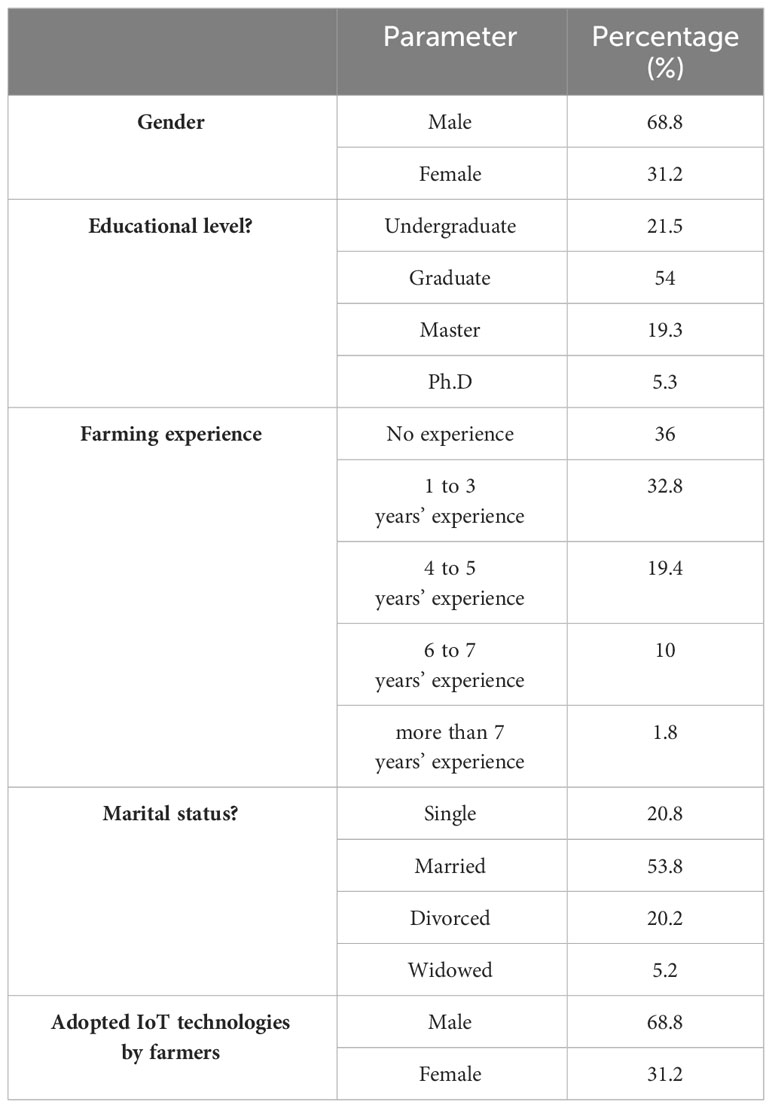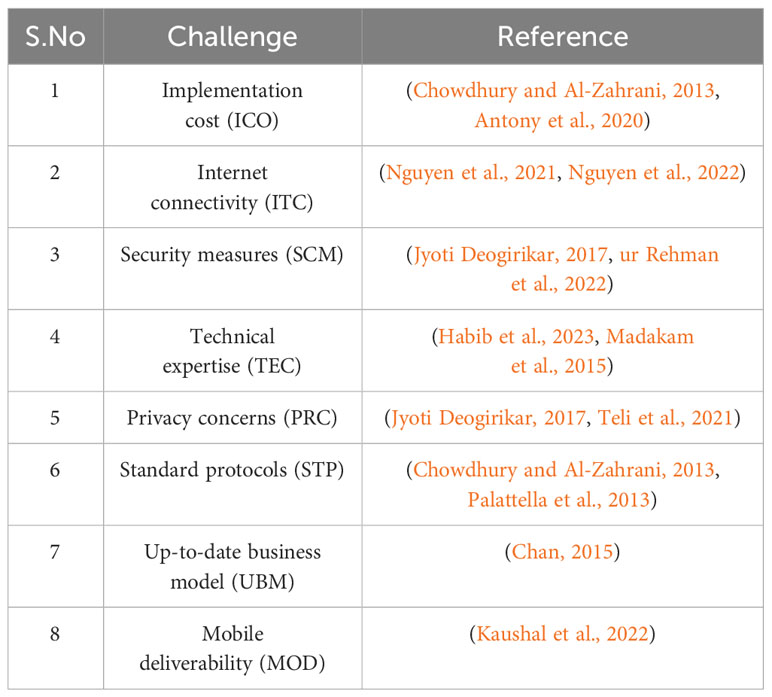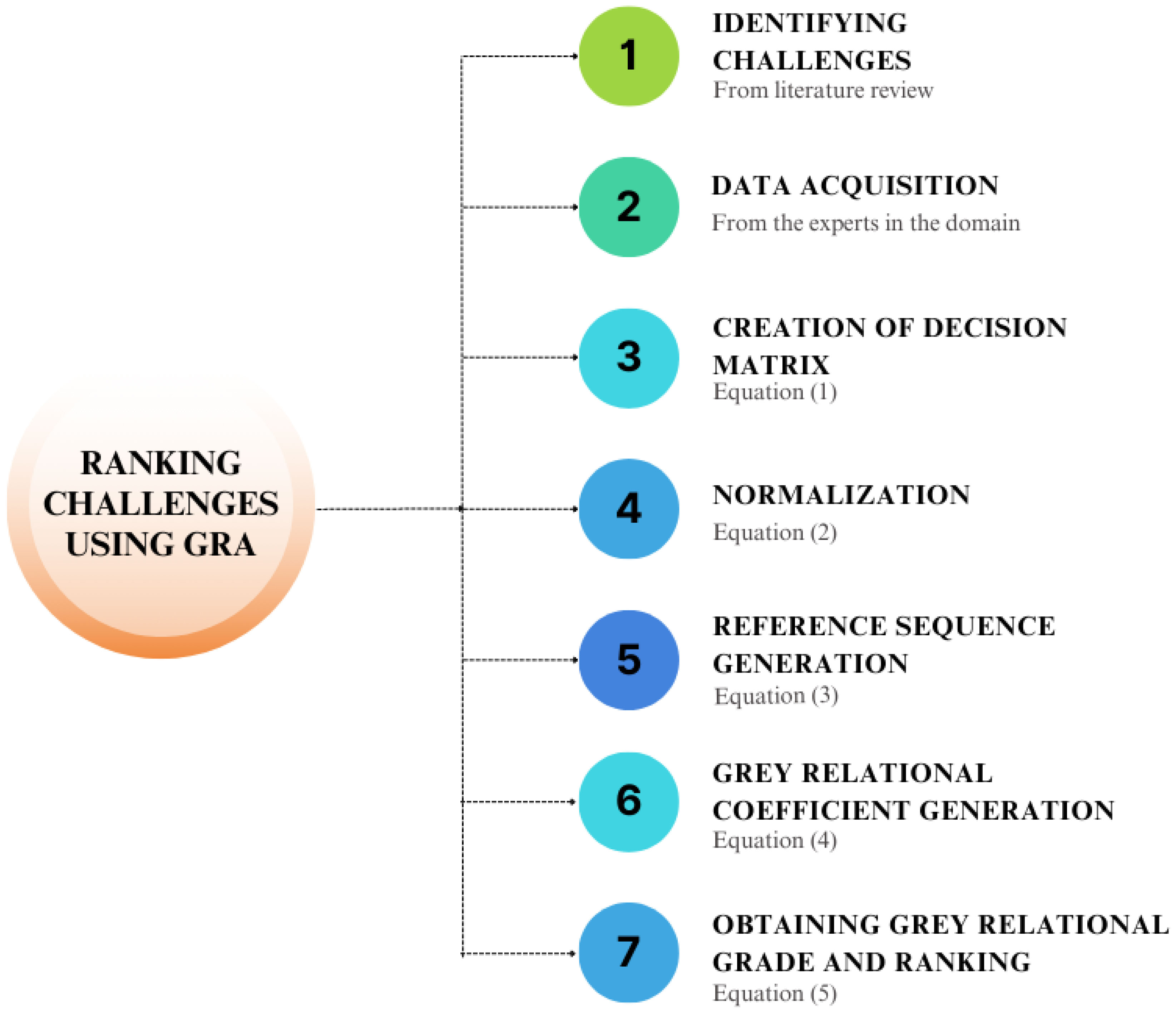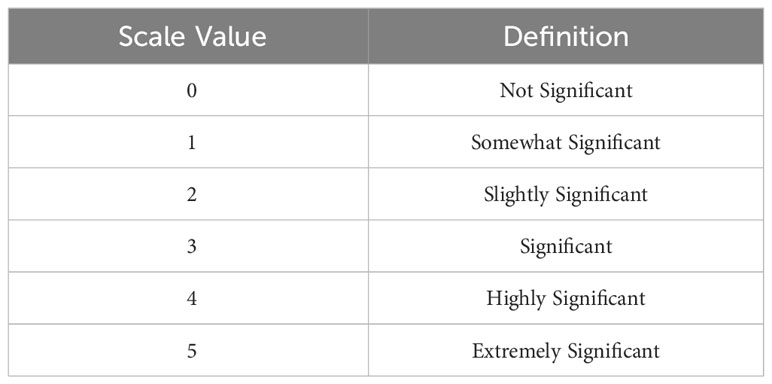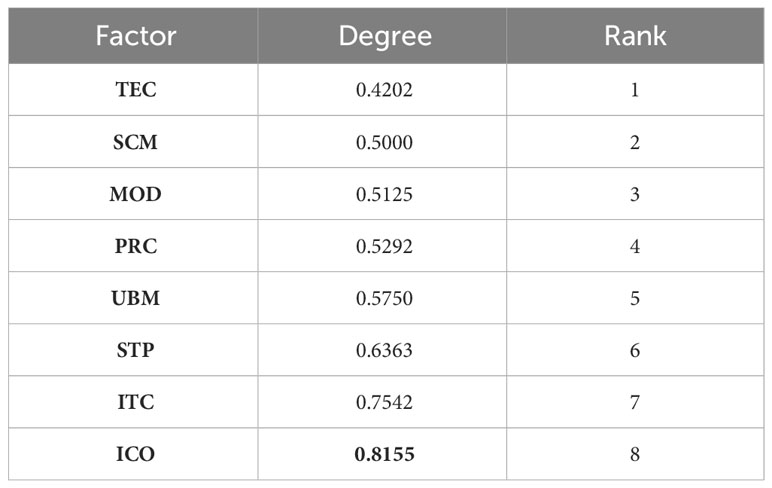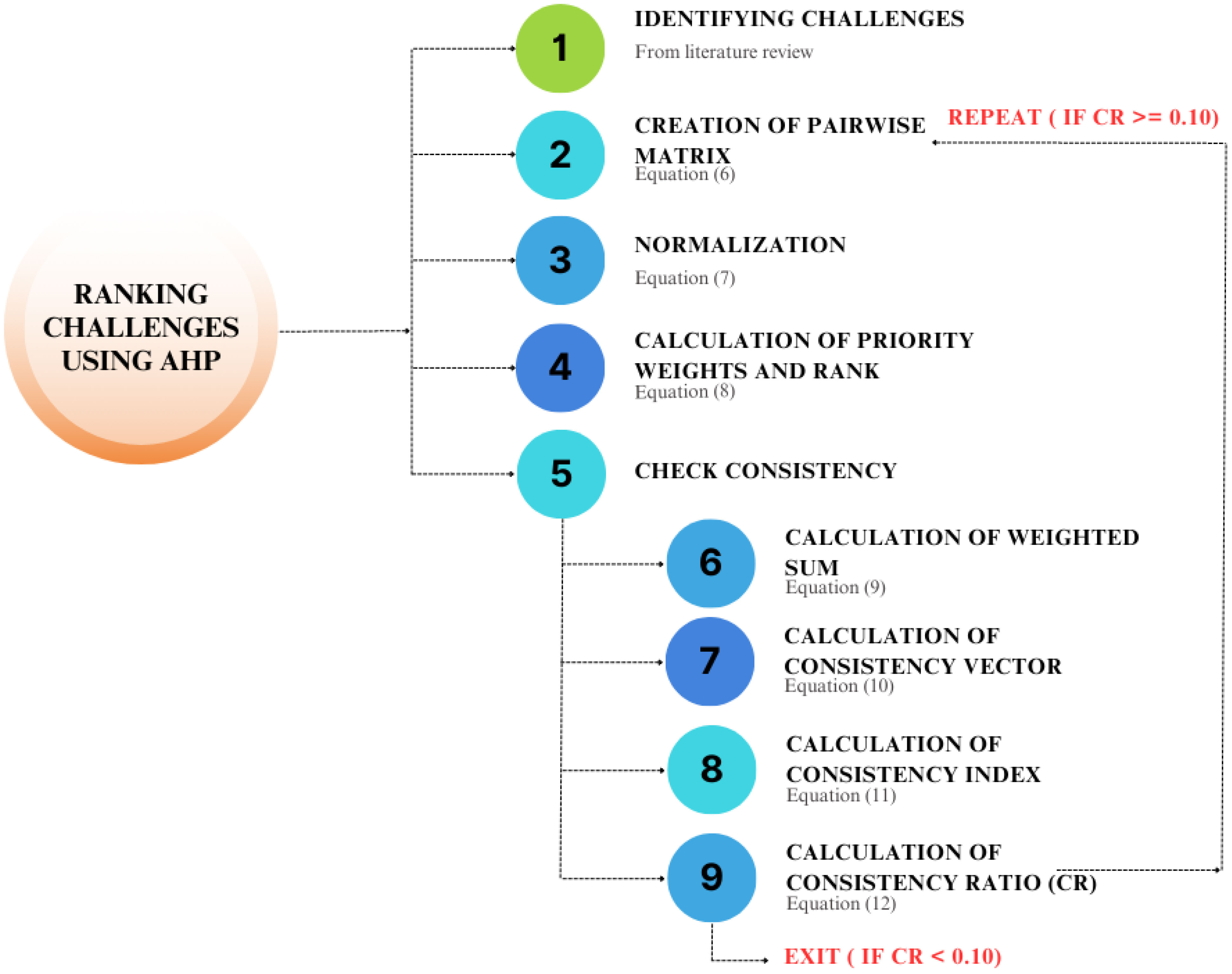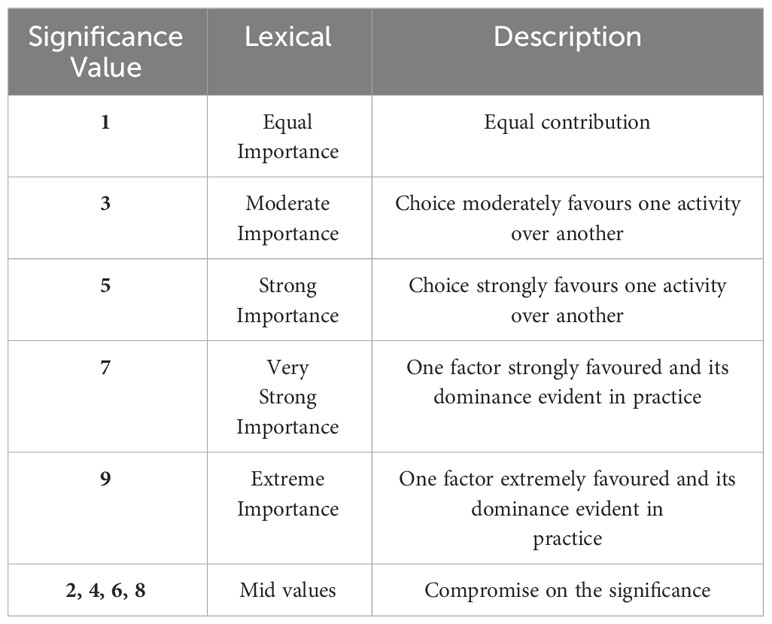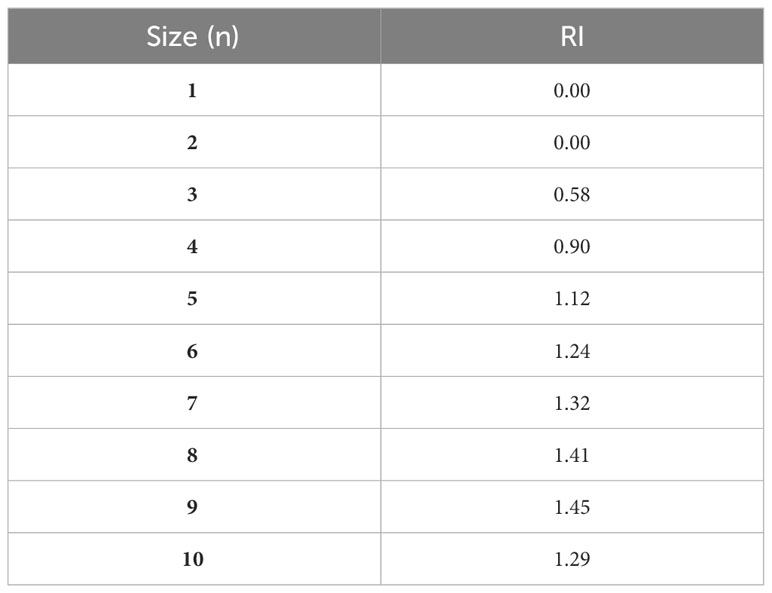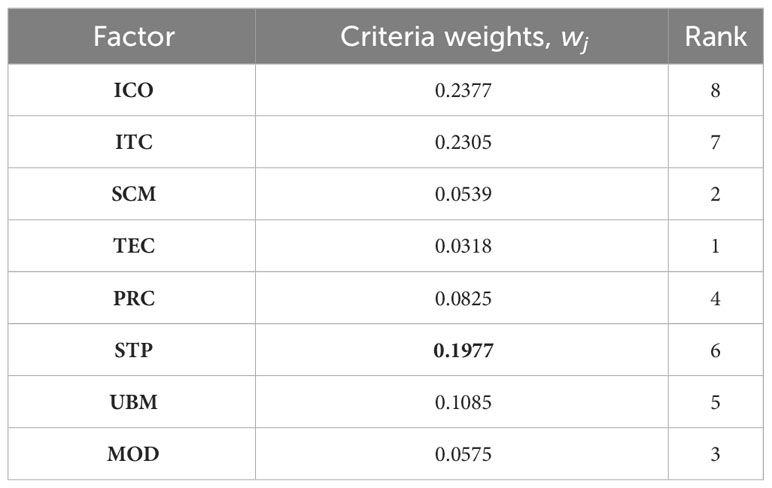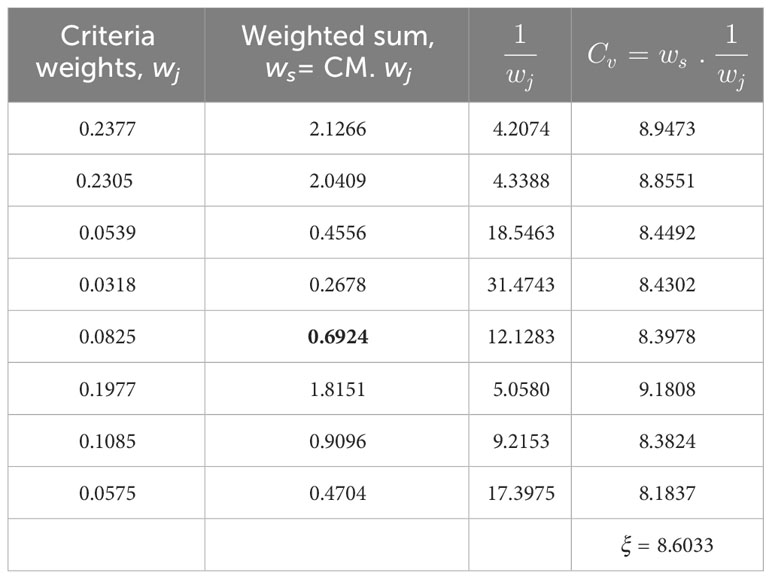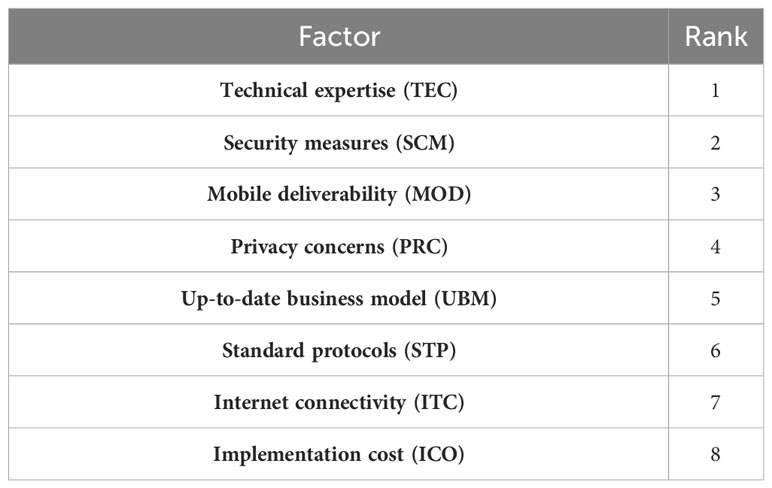Prioritizing factors for the adoption of IoT-based smart irrigation in Saudi Arabia: a GRA/AHP approach
1 Introduction
Saudi Arabia is a predominantly arid country with no permanent bodies of water and has the third-highest per capita intake of fresh water (Dinar and Donoso, 2020). The widespread agricultural programs Reilly et al. (2023) and freshwater have exhausted non-renewable groundwater and degraded the quality of water. There is a significant amount of waste in both the urban and agricultural sectors. In addition to this, due to limited rainfall, major groundwater aquifers in Saudi Arabia have been depleted. Although the total amount of freshwater produced in Saudi Arabia increased from 17.5 million cubic meters in 2010 to approximately 24 million cubic meters in 2016, the percentages of water produced from different sources remained relatively constant, as shown in Supplementary Figure 1.
KSA figures as one of the most water-scarce countries around the globe. With a hot and arid climate, limited rainfall, and a rapidly growing population and economy, the limited availability of water resources, the demand for water has far exceeded the available resources. One of the major challenges that KSA faces is irrigation, due to its limited water resources and inefficient irrigation techniques, which is critical for sustainable agriculture and food production (Dinar and Donoso, 2020).
These challenges have been discussed in several recent studies (Ghanim, 2019; Shankar, 2019), highlighting the need for innovative solutions to address water scarcity and promote sustainable agriculture. The traditional flood irrigation method, which is still widely used in KSA, is highly inefficient and wasteful, leading to water loss through evaporation and runoff (Dinar and Donoso, 2020). The demand for irrigation water Singh et al. (2023) has increased over the years due to population growth (Rambo et al., 2017), expansion of agricultural activities, and increasing urbanization. Groundwater reserves, which are the primary irrigation water source, are rapidly depleting also due to over-extraction and inefficient use (Chowdhury and Al-Zahrani, 2013). The consequences of these challenges are evident in the form of reduced crop yields and the abandonment of agricultural lands. The salinity and alkalinity of irrigation water further aggravate the situation, negatively impacting crop growth and quality, while also contributing to soil salinization and degradation. Outdated irrigation practices, including the lack of modern technologies like drip irrigation, add to the inefficiency of water usage. With the country’s population and economy expanding, the competition for water resources among the agricultural, industrial, and domestic sectors is intensifying, necessitating a well coordinated method to water management. The government has thus implemented various policies aimed at enhancing water resource management, such as promoting the utilization of treated wastewater for irrigation (Dinar and Donoso, 2020). However, the high upfront cost and lack of technical expertise limit the adoption of modern irrigation techniques like drip irrigation. Furthermore, the swift urbanization and industrialization in KSA are exacerbating the scarcity of water resources, leading to heightened competition among various sectors. To address these challenges, efforts have been made to develop a comprehensive water transmission system. However, the existing backbone is not up-to-date, even degrading in many areas. Furthermore, approximately 20% of the water that is distributed is unaccounted for (Dinar and Donoso, 2020). The kingdom of Saudi Arabia faces multifaceted challenges in the irrigation sector and requires a comprehensive approach that addresses water scarcity, salinity, inefficiency, and competition between different sectors. Efforts to promote sustainable agriculture, improve water use efficiency, and invest in modern irrigation technologies are crucial for ensuring the country’s food security and sustainable water management. Automated farming systems utilize various types of data, such as soil moisture content, temperature, rainfall, and wind speed profiles within indoor covered agriculture farm sheds (Ratnakumari and Koteswari, 2020). This data is collected and stored in a computer server to provide insights into climate prediction, soil conditions, and disturbance analysis. By utilizing these data archives, farmers can effectively monitor and analyze the conditions of their crops, which can improve the overall efficiency and productivity of their farming operations. Moreover, IoT-based irrigation systems (Shankar, 2019) can also mitigate the impact of water salinity and alkalinity on crop growth and quality. These systems can measure and control soil salinity levels, thereby ensuring crops receive the appropriate nutrients and minerals and also help address the competition for water between different sectors in KSA. By optimizing water utilization efficiency in agriculture, these systems can free up water resources for other sectors, such as urban and industrial use. Consequently, IoT-based irrigation systems offer a promising solution to the challenges faced by irrigation in KSA. By optimizing water use efficiency, improving crop yields, and reducing soil salinization and degradation, these systems can contribute to the long-term sustainability of agriculture in the country. However, identifying and ranking the challenges for the adoption of I-SIMS is a complex decision problem. When resources like time, money, or manpower are scarce, ranking facilitates efficient resource allocation. Ranking helps to maximize the effect of your decisions within the limits by concentrating resources on the options that received the highest rankings. High-ranked options are often those that fit the goals best and are more likely to produce successful results, reducing potential hazards. Despite its initial adoption several years ago, KSA has yet to fully adopt an IoT technology for efficient irrigation management due to numerous factors. To facilitate this adoption, a detailed analysis of the challenges shall be conducted. This includes identifying and ranking these challenges to determine which ones are most significant. Principal approaches such as GRA (Ju-Long, 1982) and AHP (Ayağ and Özdemir, 2007) (Rajesh and Ravi, 2015) can be utilized to determine the priority of these challenges.These approaches are both useful resources for making decisions and resolving issues in a variety of sectors. These approaches are both useful resources for making decisions and resolving issues in a variety of sectors. When dealing with systems or issues where data is scarce, ambiguous, or imprecise, GRA is highly useful. It works well in situations where incomplete data can prevent traditional quantitative analysis from producing reliable conclusions. GRA is excellent at contrasting numerous options across various aspects. Even in the absence of appropriate data, it aids in the discovery of patterns, trends, and correlations between variables. By organizing the decision-making process by dividing complex situations into a hierarchy of criteria and sub-criteria, AHP offers a systematic framework for decision-making. The advantages of both techniques can be combined to produce a more thorough and informed decision-making process with reference to Saudi Arabia. The ranking of the alternate factors is significant to achieving the goal of adopting I-SIMS by addressing each challenge one by one based on the order of ranking obtained using GRA/AHP. The decision problem can be organized using AHP, which can also identify the criteria and determine their relative weight. In order to effectively handle uncertainty and compare options, GRA can then be used within each criterion. This hybrid strategy takes advantage of both GRA’s capacity to handle complicated and ambiguous data and AHP’s quantitative prioritization. The goal of using GRA and AHP for smart irrigation in Saudi Arabia includes raising agricultural production, supporting sustainable agricultural practices, and better managing water resources, which shall assure effective water distribution, reduce waste, and encourage water conservation. These approaches can aid in selecting the most important challenges and enable KSA to move towards a successful and significant implementation of an I-SIMS. Smart irrigation systems that are dependent on measurements like evapotranspiration, are becoming more popular to enhance efficiency and timeliness compared to conventional irrigation methods. There has not been a significant study that addresses the KSA decision-problem for smart irrigation. This study will open the door for further, in-depth research into this and other KSA-related decision issue domains. Machine learning (ML), artificial neural networks (ANNs), and deep learning (DL), like the models used in Ghaderzadeh et al. (2022); Habib et al., 2023; Humayun et al., 2021; Jabbari et al., 2023; Ju-Long, 1982; Jyoti Deogirikar, 2017; Kabak and Dağdeviren, 2014; Kaushal et al., 2022; Kaya and Kahraman, 2010; Lee, 2020; Likert, 1985; Luthra et al., 2018; Madakam et al., 2015; Masoodi et al., 2019; Masoodi et al., 2021; Mohammed et al., 2021; Nguyen et al., 2022; Nguyen et al., 2021; Palattella et al., 2013; Quasim, 2021; Rajesh and Ravi, 2015; Rambo et al., 2017; Ratnakumari and Koteswari, 2020; Rawal, 2017; Reilly et al., 2023; Saaty, 1989– Sadoughi and Ghaderzadeh (2014), are often used to implement state-of-the-art proposals, such as machine vision techniques for guessing parameters of importance, such as humidity. Moreover, fuzzy logic is commonly mentioned in the literature associated with ML, ANNs, and DL, especially when fuzzy logic systems are used in irrigation control.
In this paper, firstly a discussion of related work is done in Section 2. Then an overview of the Challenges in IoT implementation in KSA is done in Section 3, followed by a detailed proposed methodology in Section 4 as well as the algorithms including GRA and AHP, followed by the results. In Section 6, the conclusion is provided and suggestions for further work.
2 Related work
To address these challenges of depleted groundwater reserves, which are the primary source of irrigation water in KSA and inefficient irrigation techniques, such as flood irrigation, which result in significant water loss, recent literature (Habib et al., 2023) has emphasized the need for innovative solutions, such as I-SIMS, to improve water use efficiency and promote sustainable agriculture. Several studies have highlighted the potential benefits of I-SIMS in KSA. For example, the researchers found that the use of an IoT-based irrigation system resulted in a significant reduction in water usage and improved crop yields in a pilot study done in KSA (Habib et al., 2023). IoT-based irrigation systems can help to overcome the challenges of water scarcity and salinity in KSA by optimizing irrigation scheduling and reducing water loss.
A comprehensive approach was urgently needed to achieve sustainable agriculture in KSA, as proposed by (Ghanim, 2019). An array of short- and long-term measures were taken in this approach. To begin the integrated solution, the effective management of existing non-renewable resources was implemented to safeguard the deep aquifer in delicate regions. To achieve this, the use of these resources was restricted solely to the provision drinking only and agricultural purposes was prohibited. Additionally, implementation of advanced water-saving techniques for irrigation, along with the cultivation of low-water requirement crops, and the enhancement of agricultural and irrigation practices resulted in significant reductions in agricultural water consumption. Increasing irrigation efficiency from 47% to 65% could result in saving more than 3 billion m3 per year. The second step in the overall solution involved creating new water resources using both traditional and non-traditional methods. To increase water availability, the utilization of treated wastewater was considered. It was important to note that treated wastewater was an essential component for irrigation in critical regions of KSA where the deep ground water aquifer was alarmingly low due to excessive use. Additionally, the development of rain-fed agriculture and more effective water collection practices were highly recommended in the country’s southwestern part, specifically on the deserted terraces of the AI Sarawat mountains and along the Red Sea coasts. These areas received annual runoff water from nearby and moderately damp mountains, which could be harnessed through appropriate infrastructure and management techniques. The authors in (Shankar, 2019) designed a smart irrigation system powered by Raspberry Pi and utilizing IoT technology. The system automatically controlled the water motor and tracked plant growth by utilizing a webcam. By connecting to a WI-FI network, the live stream of the farm could be accessed through a mobile phone application.
The authors in (Quasim, 2021) covered a variety of topics including market size, notable IoT players, market predictions, academic considerations, overall architecture, opportunities, and challenges. The authors noted that the public’s openness to adopting new technologies and the desire for a technologically advanced society were positive factors for the successful implementation of IoT-based systems in Saudi Arabia. The researchers in (Rawal, 2017) presented a system that involved the development of an automated irrigation system that ensured the soil’s desired moisture content was maintained through automatic watering. The control unit was created using a microcontroller (ATMEGA328P) on the Arduino Uno platform. Sensors were used to read moisture levels of soil which in turn was used to extrapolate the adequate amount of water necessary for irrigation. Furthermore, IoT technology was integrated to keep farmers updated on sprinkler status. The sensor data was frequently updated on a web page through a GSM-GPRS SIM900A modem, allowing farmers to check whether the water sprinklers are ON/OFF in real time. The authors in (Campoverde et al., 2021) presented a suggestion for an irrigation system that utilized IoT technology. The system utilized sensors and hardware platforms like Raspberry PI and Arduino to facilitate irrigation methods on farms. The water pumps used for irrigation were controlled by two crucial factors: soil moisture and evapotranspiration. To predict the adequate water levels necessary for the plants, RL was used in tandem with an MDP. This method helped in the reduction of water and energy needs. The proposed system was analyzed and compared to a traditional irrigation system that used a soil moisture threshold to make decisions. The experiments conducted demonstrated that the proposed method could save both water and energy. The study conducted by (Vallejo-Gómez et al., 2023) provided a systematic review using a modified version of the PRISMA 2020 approach to identify important aspects related to smart technologies used in irrigation systems. The review emphasized, as shown in Supplementary Figure 2, that there was a recent increase in research on smart technologies for irrigation system control and modelling. The authors suggested that this research area had great potential for further contributions. The review also found that embedded systems were generally used to implement smart irrigation systems. IoT-based systems are frequently used in smart irrigation systems due to their simplification in usage and data exchange between devices, which makes data collection and monitoring easier.
It is important to mention that implementing and adopting an I-SIMS requires identifying and ranking of the challenges. Numerous studies have explored the use of AHP, GRA. Notably, (Kaya and Kahraman, 2010) employed fuzzy VIKOR and AHP methods for identifying the optimal energy source and energy manufacturing locations in Istanbul. The authors in (Chang, 2015) utilized MCGP to determine the ideal plant types, locations, and other criteria for the expansion of the renewable energy industry. The researchers in (Kabak and Dağdeviren, 2014) proposed an approach using BOCR and ANP to evaluate Turkey’s energy position and rank renewable energy parameters, taking both tangible and intangible challenges into account. The authors in (Zografidou et al., 2016) applied a 0-1 weighted GP model to develop the best design for a renewable energy production network in Greece, incorporating social, environmental, and economic criteria. The authors in (Atmaca and Basar, 2012) focused on evaluating the correctness of inplace and future power plants in Turkey.
3 Challenges
To analyse and identify irrigation difficulties/challenges in the Kingdom of Saudi Arabia (KSA), a defined procedure for gathering and analyzing pertinent literature on the subject was followed. The question “What difficulties do irrigation techniques in the Kingdom of Saudi Arabia face?” provided insights into the factors that affect irrigation in KSA. By using relevant keywords and synonyms connected to irrigation, IoT and Saudi Arabia, many relevant publications and ideas were highlighted. use of pertinent institutional repositories and academic databases (such as PubMed, Web of Science, and Scopus) aided in finding most of the studies done in this domain. Reviewing the titles and abstracts of the search results also helped narrow down the choices. Many irrelevant papers were eliminated. Finally, a quality assessment verified the validity and reliability of the studies that were included.
3.1 Resources searched
The process of selecting appropriate resources for conducting a Systematic Literature Review (SLR) is crucial. In our case, we opted to utilize five widely recognized digital libraries that primarily catalog publications in the field of computer science. These libraries served as our primary sources for identifying all relevant literature pertaining to our research inquiries. 1. Scopus: (www.scopus.com), 2. (IEEE: ieeexplore.ieee.org), 3.MDPI: (www.mdpi.com), 4.Springer: (www.springer.com), 5. Google Scholar: (scholar.google.com) and 6. Frontiers Library (https://www.frontiersin.org/).
3.2 Constructing search string
The search query was designed based on three fundamental concepts: “KSA,” “water,” and “irrigation” as shown in Table 1 Our search string is formed by combining different variations of these three keywords using the Boolean operators “AND” and “OR”.
3.3 Article selection process
In Supplementary Figure 3, the comprehensive procedure for searching and identifying pertinent publications is illustrated. Initially, we formulated a search string that encompassed keywords pertinent to our Systematic Literature Review (SLR). Subsequently, we executed the search query in the leading five digital libraries that index computer science literature.
Supplementary Figure 3 delineates the subsequent stages, including the article selection process, culminating in the meticulous review of a selected set of 51 articles.
Figure 1 defines the exclusion and inclusion criteria as follows.
Based on the literature and validation from domain experts, the challenges that Saudi Arabia may face in the adoption of IoT-based irrigation systems include:
Implementation cost (ICO): The cost of implementing IoT-based irrigation systems is relatively high (Antony et al., 2020), which could be a major challenge for farmers, especially small-scale farmers. The cost of sensors, communication equipment, and other components of IoT-based irrigation systems can be prohibitive for some farmers. Constructing an affordable, widely-supported smart agriculture platform to improve small-scale farmers’ irrigation efficiency, save water in a variety of crops with different water needs at different stages of growth, and yield excellent results Saqib et al. (2020). To increase agricultural field output, precision agriculture makes use of computers, sensors, artificial intelligence, and automation. It keeps an eye on the environment at the same time to encourage the preservation of soil, water, and other natural resources, with a focus on agricultural sustainability in particular. However, the accompanying expenses of data monitoring and recording technology prevent their broad implementation in agriculture Ferrarezi and Peng (2021). The Table 2 below gives approximate cost of a simple automated irrigation system Ferrarezi and Peng (2021).
The cost is about $400 with one sensor and $1000 with 4 sensors which is not a feasible expense for a low-budget farmer.
Internet connectivity (ITC): Another challenge is the lack of infrastructure, such as reliable internet connectivity and power supply (Nguyen et al., 2021). These systems require a reliable power supply and a stable internet connection to transmit data, which could be a challenge in remote areas with poor infrastructure (Nguyen et al., 2022). The research study done by Jabbari et al. (2023) encompasses a study on farmers and the use of IoT for crop monitoring in Saudi Arabia and the study suggested that the farmers in Saudi Arabia are highly engaged and interested in using IoT technologies for crop monitoring. According to this study, when it came to agricultural experience, 36.0% of respondents had none at all. 32.8% of those with experience had been farming for one to three years, 19.4% for four to five years, 10.0% for six to seven years, and 1.8% for more than seven years. These results show a mix of seasoned and inexperienced farmers, providing insights into their respective viewpoints on the uptake of IoT technology. 28% of people were single, 53.8% were married, 20.2% were divorced, and 5.2% were widowed. This variation in marital status offers a thorough insight into farmers’ various living circumstances and viewpoints about the deployment of IoT technologies. Among the farmers polled, 68.8% of the males and 31.2% of the females had used IoT technology, indicating a possible gender difference in adoption in Saudi Arabia particularly Jizan as shown in Table 3 and bar chart in Supplementary Figure 4. The study also clarifies the understanding of farmers’ attitudes and behaviours when it comes to using IoT technology for activities like crop monitoring, health assessment, growth tracking, and yield prediction.
Security measures (SCM): IoT offers a dependable means of exchanging data between a vast array of devices, with the crucial requirement that this exchange is safeguarded against tampering and other malicious attacks (Jyoti Deogirikar, 2017). Security issues in IoT are a major concern because IoT devices are in direct communication on the internet and are efficient for collecting, processing, and transmitting sensitive data. This data can include personal information, financial data, and sensitive business data, among other things. Many IoT devices have weak security mechanisms, making them vulnerable to hacking and cyber-attacks. This can lead to data breaches, unauthorized access to systems, and other security incidents (ur Rehman et al., 2022). There is currently a lack of standardization in IoT security, which makes it difficult to implement consistent and effective security measures across different devices and systems. IoT devices and systems may rely on third-party services or software, which can introduce additional security risks if these services or software are not properly secured. It is important to implement strong security measures throughout the entire IoT ecosystem, including device design, data collection and storage, data transmission, and user access control. This includes implementing robust encryption, authentication, and access control mechanisms, regularly updating and patching IoT devices and systems, and providing clear and transparent information about security practices to users.
Technical expertise (TEC): One of the significant challenges is limited awareness (Madakam et al., 2015) among farmers about the benefits and usage of these systems. Farmers may lack the technical knowledge required to implement and maintain IoT-based irrigation systems. Farmers need to be educated about the potential advantages of IoT-based irrigation systems, such as reduced water consumption, increased crop yield, and decreased labour costs. Precision agriculture practices, such as using sensors to monitor soil moisture and temperature, are not yet widely adopted in Saudi Arabia, which could limit the adoption of IoT-based irrigation systems.
Privacy concerns (PRC): IoT-based irrigation systems involve the collection and transmission of sensitive data, such as crop yields, soil moisture levels, and weather conditions. Therefore, there is a risk of data privacy (Deogirikar and Vidhate, 2016; Teli et al., 2020) which could be a significant challenge for farmers. IoT devices can be vulnerable to cyber-attacks, which can result in data breaches and expose personal and sensitive information to unauthorized parties. IoT devices may share data with third-party services or other devices in ways that users may not be aware of or consent to, potentially leading to the misuse of their data. IoT devices may have weak security or encryption mechanisms, making it easier for attackers to access and steal personal data. Many IoT devices and services do not provide clear information about how data is collected, processed, and used, or give users control over their data. IoT devices can be used to track and monitor individuals without their knowledge or consent, potentially infringing on their privacy and civil liberties. To address these concerns (ur Rehman et al., 2022), it is important to implement strong privacy measures throughout the entire IoT ecosystem, including device design, data collection and storage, data sharing, and user consent and control. This includes implementing robust encryption, authentication, and access control mechanisms, providing clear and transparent information about data practices, and giving users meaningful choices and control over their data.
Standard protocols (STP): The IoT landscape is rapidly evolving, with new devices and technologies being developed all the time. This means that existing protocols may not be able to keep up with the changing needs and requirements of IoT (Palattella et al., 2013). Also, the sheer scale and complexity of IoT networks require protocols that can support large numbers of devices, handle high volumes of data, and operate in different environments and contexts. IoT devices and systems have unique requirements that may not be fully addressed by existing protocols. For example, some IoT devices have limited processing power or memory and may require lightweight protocols that can operate efficiently on these devices. Up-to-date business model (UBM): Business models should be up-to-date to run on IoT for several reasons. Firstly, IoT is a rapidly evolving technology that requires businesses to constantly adapt and update their models to remain competitive. Outdated models may not be able to fully utilize the capabilities of IoT, resulting in missed opportunities for optimization and cost savings (Chan, 2015). Secondly, IoT introduces new possibilities for data collection, analysis, and automation. To take advantage of these opportunities, businesses must have models that are designed to incorporate and leverage the data and insights provided by IoT devices. IoT also presents new security risks and challenges that require businesses to have updated models and strategies to effectively mitigate and manage these risks. Failure to keep up with these risks could result in costly data breaches or other security incidents.
Mobile deliverability (MOD): Providing mobile services to users in IoT (Kaushal et al., 2022) is important because it enables users to access and interact with IoT devices and services from anywhere, at any time. By incorporating mobile capabilities into IoT devices and services, businesses can enhance the user experience and improve the accessibility and usability of their products. Mobile services enable users to access and interact with IoT devices and services from their smartphones or tablets, providing a more convenient and accessible user experience. It can provide users with real-time notifications and alerts related to their IoT devices and services, enabling them to stay informed and take prompt action if needed. Users can remotely control and monitor their IoT devices and services from anywhere, providing greater flexibility and convenience. Mobile services can provide businesses with valuable data on user behaviour, preferences, and usage patterns, enabling them to make data-driven decisions and improve their products and services over time.
The final list of identified eight challenges is given in Table 4.
It is imperative to note that the relative significance of these challenges may vary depending on the specific context and region within Saudi Arabia. In conclusion, the challenges facing irrigation in KSA continue to be significant, but recent literature suggests that innovative solutions, such as IoT-based irrigation systems, could help to enhance the utilization efficiency and promote sustainable agriculture. Efforts to increase the implementation and adoption of these technologies are crucial for ensuring the country’s food security and sustainable water management.
4 Proposed methodology
Academics and professionals have investigated several factors and challenges involved in the adoption of an I-SIMS in KSA. This investigation requires the collection of expert insights, opinions regarding the significance of various challenges, and assessments of the relationship between these challenges, which are highly subjective and indeterminate. In order to tackle the uncertainty and imprecision inherent in this area, various researchers have employed the GRA methodology. For example, (Song et al., 2014) applied GRA within QFD to rank technical attributes based on customer expectations. Similarly, citepOmoniwa2014 utilized GRA to address multi-criteria selection issues in the field of robotics. The authors in (Tosun, 2006) optimized drilling process parameters utilizing GRA, while (Sharma et al., 2018) applied GRA to minimize food loss by assessing food safety and security risks. In another study, (Tsaur et al., 2017) evaluated the operational performance of six TFT and LCD products by analyzing both current and predicted future performances with GRA.
This study has identified eight challenges that influence the adoption of an I-SIMS in KSA. However, the information available about these factors is uncertain and incomplete, which makes it challenging to construct a reliable model. There is a lack of a well-defined strategy for the adoption process of an I-SIMS in KSA, which adds to ambiguity in decision-making. Since implementing SIMS is a complex and multifaceted task, the correlation between various influencing challenges can be blurry. Systems characterized by imprecise and uncertain information are commonly referred to as “grey.” Within the realm of MCDM, especially when decision-making involves uncertainty, GRA is a highly effective evaluation methodology (Luthra et al., 2018). Thus, GRA can be leveraged to establish a dependable model that addresses the uncertainty and unpredictability of complex decision-making processes by ranking each challenge and predicting its potential impact on the implementation of I-SIMS in KSA. Therefore, the GRA methodology is an appropriate tool to rank the challenges.
AHP is another commonly used technique in MCDM problem domains. Developed by mathematician and operations researcher Thomas Saaty (Saaty, 1989) in the 1970s, AHP could be established as a structured methodology for analyzing complex decisions, particularly those that involve multiple criteria or alternatives. AHP entails breaking down a decision problem into a hierarchy of criteria and then assessing each criterion in terms of its relative significance to the overall decision. This is accomplished through pairwise comparisons made by experts in the field, in which each parameter is compared to every other parameter with respect to its relative significance. The comparisons are subsequently converted into numerical values, which are employed to calculate weighted scores for each criterion. In addition, AHP involves evaluating each alternative in terms of how well it satisfies each criterion, with pairwise comparisons made between each alternative and every other alternative in terms of their performance on each criterion. The comparisons are then translated into numerical values, which are used to calculate a score for each alternative. The scores for each alternative are combined with the weighted scores for each parameter to produce an overall ranking of the factors/alternatives. The decision-maker’s pairwise comparisons are evaluated for consistency using the Consistency Ratio (CR) and Consistency Index (CI). The CR is the difference between the CI and an average CI that was created at random given a set of consistent judgments. To assess if pairwise comparisons are sufficiently consistent, the CR value is utilized. A CR value of 0.10 or below is typically regarded as satisfactory and denotes reasonable consistency. The CI calculates how far the pairwise comparisons differ from a set of judgments that are fully consistent. The AHP has been widely used in business, engineering, and other fields to support decision-making in a variety of contexts, including project management, supplier selection, and product design. In this study both GRA and AHP have been used to rank the alternatives.
4.1 Grey relational analysis
Figure 2 illustrates the process of ranking the challenges in the implementation of an I-SIMS in the Kingdom of Saudi Arabia using GRA. It encompasses four main stages: identifying challenges from the literature, collection of data using expert opinion, GRA methodology, and ranking of the factors. Step 1 and Step 2 shown in Figure 2 have already been discussed in the previous section in which eight challenges were identified in the current literature. The complete algorithm for GRA is given as follows:
Step 1: Make a decision matrix using expert knowledge. A 6-point scale as shown in Table 5, is used in this study to mark the importance of challenges. The domain experts are consulted and the data is collected to make the decision matrix using Equation 1.
Where dij, 1 ≤ i ≤ u, 1 ≤ j ≤ v represents the significance value by an expert (i) for a challenge (j).
Step 2: This step involves the normalization of the data collected from experts using Equation 2.
Where φ and ϕ represent functions that return the minimum and maximum of given values, dij respectively.
Step 3: Next the normalized values are used to calculate the reference sequence for all challenges in the range [0,1]. This is achieved as given in Equation 3.
Where ϕ represents a function that returns the maximum of given values, d′ij.
Step 4: In this step, the GRC matrix is calculated as given in Equation 4 in order to find the correlation to the reference sequence calculated in the previous step.
Where ρ = 0.5 and is known as the Grey Relational Coefficient and φ and ϕ represent functions that return the minimum and maximum of given values, sij respectively.
Step 5: This step involves the calculation of the Degree (D) or Grey Relational Grade Matrix, which is a single-column matrix calculated as given in Equation 5.
Finally, the challenges are ranked.
4.1.1 Results
After an extensive review of the available literature, a total of eight challenges (ICO, ITC, SCM, TEC, PRC, STP, UBM, MOD) that have a direct impact on the adoption of an I-SIMS in KSA were identified. These factors were then validated in consultation with domain experts. The experts included eight individuals from both academia and industry, and a scale was prepared after discussions with them. Data was collected from the experts using a Likert scale (Likert, 1985) ranging from 0 to 5 shown in Table 5, where 0 represents no influence and 5 represents very high influence. The ratings provided by the experts were used to construct a decision matrix, which is presented in Table 6 and outlines the influencing challenges to the adoption of an I-SIMS in KSA.
The next step encompasses the normalization of data obtained in Table 6. It is done using Equation 2. For example, for (PRC, #6), the value 0.2500 is obtained as:
The results of normalization for all s is shown in Table 7:
Next, the Reference Sequence Generation (RSG) is done using Equation 3. For example, for (SCM, #3), the value 0.500 is obtained as:
The results of RSG for all sij’s is obtained as shown in Table 8.
Now, the Grey relational coefficient calculation (GRC) is generated using Equation 4. For example. For (STP, #6), the value, 0.400 is obtained as:
The results of GRC for all λij’s is obtained as shown in Table 9.
Finally, the degree is calculated using Equation 5. For example, for ICO, the degree value is calculated using Equation 5 as:
The degree for all alternatives and the corresponding rankings are obtained as given in Table 10. In the next section, AHP methodology is applied to revise, verify and validate the results obtained using GRA.
4.2 Analytical hierarchical process
AHP is another approach that is used in MCDMs. AHP operates by incorporating comparisons and a systematic approach to minimize bias in the sequence of decisions (Saaty, 1989). The process involves a 9-point scale.
Figure 3 illustrates the process of ranking the challenges in the implementation of an I-SIMS in the Kingdom of Saudi Arabia using AHP. It encompasses four main stages: identifying challenges from the literature, creation of a pairwise matrix, normalization and calculation of priority weights, ranking of the factors and finally confirming the consistency of the pairwise matrix.
The complete AHP algorithm is given as under:
Step 1: Identifying the most significant challenges or factors that have a direct effect on the adoption of an I-SIMS in the Kingdom of Saudi Arabia.
Step 2: Creation of an n x n pairwise comparison matrix where n depicts the number of challenges identified in step 1. The pairwise comparison is done according to the significance values and using Equation 6 shown in Table 11 as:
as defined in Table 11.
Step 3: In this step, normalization is done by using Equation 7.
Step 4: In this step, the priority/criteria weights and ranking of challenges are calculated using Equation 8.
Step 5: Check the consistency of the comparison matrix as follows:
1. Calculate weighted sum using Equation 9.
2. Calculate consistency vector using Equation 10.
3. Calculate consistency index using Equation 11.
4. Calculate consistency ratio (CR) using Equation 12.
Where RI is Random Index given in Table 12 for different values of n as follows:
5. Check if CR < 0.10, then.
The matrix and rankings are consistent, EXIT.
Else
The comparison matrix (CM) should be recalculated.
Repeat Step 2.
4.2.1 Results
After identifying the challenges that impact I-SIMS adoption in KSA, the comparison matrix was generated by consulting with domain experts from both industry and academia. Using Table 11 and Equation 6, the value of significance is inserted for each pair of alternatives, and a pairwise comparison matrix is obtained given in Table 13 as follows:
The second step involves the normalization of the pairwise comparison matrix values using Equation 7. For example, for (ITC, TEC) pair, the value 0.1786 is obtained as:
The results of normalization for all .s is obtained as shown in Table 14 as shown below:
Next, the calculation of priority weights is done using Equation 8. For example, for STP, the value 0.1977 is calculated as:
The results of priority weights and the corresponding ranks for all wj’s is obtained and shown in Table 15.
Now, in order to validate the ranking obtained using the pairwise matrix in Table 10, the comparison matrix needs to be consistent with the values provided and verified by the domain experts because any inconsistency in the values of the pairwise matrix shall mean unreliable data which shall point to unreliable ranking. To check consistency, the weighted sum is calculated using Equation 9, for example for w5, ws(w5) = ws(0.0825) = 0.6924. The values for all weighted sums are obtained by the dot product of CM with the criteria weights vector, as shown in Table 16.
Similarly, the consistency vector is obtained by the dot product of weighted sum, wswith , as shown in Table 16.
In the next step, the CI is calculated as:
The random index (RI) for the matrix size 8 is given as 1.41 as shown in Table 12. Therefore, the CR is obtained as:
Since CR = 0.0611 is less than 0.10, the comparison matrix is consistent.
5 Discussion
Both GRA and AHP confirm that the challenges are ranked given in Table 17:
Technical expertise and a skilled workforce (TEC) surfaced as the most important challenge in the adoption of an IoT-based irrigation system in KSA. There are various reasons that support the obtained result as follows:
Technical Complexity: Implementing and managing an IoT-based irrigation system requires a certain level of technical expertise, including knowledge of sensor installation, data collection, data analysis, system configuration, and troubleshooting. Farmers and agricultural stakeholders may require specialized skills to operate and maintain the IoT devices and systems, which can be a challenge if they lack the necessary technical expertise (Catota et al., 2019).
Limited Availability of Skilled Workforce: In some regions of KSA, there is a limited number of skilled workforce, including technicians, engineers, and other professionals with expertise in IoT technologies. This can pose challenges in finding qualified personnel to design, install, configure, and maintain IoT-based irrigation systems, which may result in delays or inefficiencies in the adoption process.
Training and Education: Providing adequate training and education for farmers and other stakeholders to understand and use IoT-based irrigation systems effectively can be challenging. The lack of accessible training programs, resources, and educational materials for farmers to learn about IoT technology and its application in agriculture can be a barrier to adoption.
Language and Cultural Barriers: Language and cultural barriers can be a challenge in adopting IoT-based irrigation systems in Saudi Arabia. The technical documentation, user manuals, and training materials for IoT systems may be predominantly available in English or other languages, which may pose difficulties for farmers who are not proficient in these languages. Additionally, cultural norms and practices related to technology adoption may influence the willingness and ability of farmers to adopt and use IoT-based irrigation systems (Eysenbach and Jadad, 2001).
Upgrading Existing Skills: Adopting IoT-based irrigation systems may require farmers and other stakeholders to upgrade their existing technical skills and knowledge to adapt to the new technology. This can be a challenge for farmers who have been using traditional irrigation methods and may not be familiar with IoT concepts, data-driven decision-making, and digital technologies.
Cost of Hiring Skilled Workforce: Hiring skilled workforce with expertise in IoT technologies can be costly, especially for small-scale farmers or those with limited financial resources. The cost of hiring or training personnel with the necessary technical skills to implement and manage an IoT-based irrigation system can be a challenge, making it less financially viable for some farmers.
Addressing the challenge of technical expertise and skilled workforce in the adoption of IoT-based irrigation systems in Saudi Arabia may require providing training and education programs tailored to the needs of farmers and stakeholders, promoting the development of local talent in IoT technologies, and providing resources and support to upgrade existing skills. Collaborations between government, educational institutions, and industry stakeholders can play a vital role in addressing this challenge and promoting the successful adoption of IoT-based irrigation systems in the agricultural sector.
Secondly, Security Measures (SCM) are ranked as the second most important challenge, which could be attributed to the following reasons:
Data Security: IoT-based irrigation systems generate and transmit a huge amount of data, including sensitive information such as crop data, water usage, and weather conditions. Ensuring the security of this data is crucial to protect it from unauthorized access, data breaches, or cyber-attacks (Teli and Masoodi, 2023). Breaches in data security can result in financial losses, compromise farmers’ privacy, and disrupt the normal operation of the irrigation system (Humayun et al., 2021).
Device Security: IoT devices, including sensors and communication devices used in irrigation systems, can be vulnerable to security threats (Masoodi et al., 2021). These devices may lack robust security features or may have vulnerabilities that could be exploited by malicious actors to gain unauthorized access or control over the system. Ensuring the security of these devices is important to prevent unauthorized tampering, manipulation, or disruption of the irrigation system.
Network Security: The communication networks used to transmit data in IoT-based irrigation systems, such as wireless (Teli et al., 2022) or cellular networks, can be susceptible to security threats. Unauthorized access to the network, interception of data, or denial of service attacks can disrupt the communication between devices and the central system, affecting the reliability and performance of the irrigation system (Abdullah et al., 2019).
Physical Security: Protecting the physical infrastructure of the IoT-based irrigation system, including sensors, communication devices, and control systems, from theft, vandalism, or tampering is crucial. Physical security measures, such as securing access points, using tamper-proof devices, and implementing surveillance systems, may be necessary to safeguard the system from physical security threats.
Compliance and Regulations: Adhering to relevant regulations and compliance requirements related to data privacy, cybersecurity, and other legal aspects can be challenging in the adoption of IoT-based irrigation systems. Complying with local regulations, industry standards, and best practices for IoT security may require additional resources, expertise, and effort, which can pose challenges to adoption. Awareness and Training: Ensuring that farmers and agricultural stakeholders know the security risks associated with IoT-based irrigation systems and providing them with the necessary training and knowledge to mitigate these risks can be challenging. Lack of awareness and understanding of security best practices among end-users can result in unintentional security lapses or vulnerabilities in the system.
Addressing these security challenges (Teli et al., 2021) in the Kingdom of Saudi Arabia requires implementing robust security measures, including encryption, authentication, access control, and regular security audits, to protect the data, devices, and networks used in IoT-based irrigation systems. Providing education, training, and awareness programs to farmers and stakeholders about security best practices and compliance requirements can also contribute to the secure adoption and implementation of I-SIMS in the agricultural sector.
Mobile deliverability (MOD) is an important challenge in which the problem of providing services to each stakeholder with mobile and remote devices shall be made available 100% of the time.
Power Supply and Connectivity: IoT-based irrigation systems rely on a stable power supply and connectivity to transmit data from sensors to a central system. However, in some remote agricultural areas of Saudi Arabia, accessing a stable power supply and reliable internet connectivity may be challenging and expensive, which can increase the overall mobile deliverability of services and maintain an I-SIMS (Adli et al., 2023). Affordability for Farmers: Farmers in Saudi Arabia may face financial constraints in adopting IoTbased irrigation systems, especially small-scale and subsistence farmers. The initial setup cost, ongoing maintenance, and operational expenses may be beyond the budget of many farmers, making it difficult for them to adopt and sustain the technology (Mohammed et al., 2021) and inhibiting remote service deliverability.
Privacy Concerns (PRC) is also a top challenge due to the following reasons:
Cultural and Religious Considerations: Saudi Arabia has a unique cultural and religious context where privacy is highly valued, and strict regulations are in place to protect the privacy of individuals and organizations. The Islamic principles of privacy and modesty, as well as the social norms and customs, can influence the perception of privacy in the adoption of IoT-based irrigation systems. There may be concerns about the potential intrusion of privacy, particularly if the systems involve monitoring of private spaces, such as farms, fields, or agricultural facilities.
Data Privacy and Security Concerns: IoT-based irrigation systems rely on data collection and transmission through various sensors and devices. This data can include sensitive information such as crop yield, soil conditions, weather data, and water usage patterns (Habib et al., 2023). Ensuring the privacy and security of this data is critical to prevent unauthorized access, data breaches, and misuse of information. There may be concerns about the collection, storage, and handling of data by IoT-based irrigation systems, particularly if the data is transmitted over the Internet or stored in cloud-based systems (Masoodi et al., 2019).
Compliance with Data Protection Regulations: Saudi Arabia has implemented the Saudi Data and Artificial Intelligence Authority (SDAIA), which governs and regulates data and AI-related activities in the country. Compliance with data protection regulations, such as the Saudi Data Protection Law (SDPL), is important in the adoption of IoT-based irrigation systems. This may require additional measures to protect the privacy and security of data collected and transmitted by these systems, including obtaining proper consent, ensuring data is used for the intended purpose, and providing individuals with control over their personal information.
Ownership and Control of Data: Farmers and other stakeholders may have concerns about who owns the data generated by the IoT devices and systems, who has access to the data, and how the data is used. Ensuring that farmers have control over their data and that it is used in a manner that aligns with their privacy preferences and requirements can be a challenge in the adoption process. There may be concerns about data being used for commercial purposes or shared with third parties without proper consent, which can raise privacy concerns.
Lack of Awareness and Understanding: Farmers and other stakeholders may have limited awareness and understanding of the privacy risks associated with IoT-based irrigation systems. They may not be familiar with the types of data that are collected, how the data is transmitted, stored, and used, and the potential privacy implications. This lack of awareness and understanding can hinder the adoption of IoT-based irrigation systems, as farmers may be hesitant to adopt new technologies without a clear understanding of the privacy risks and how they can be mitigated.
Cybersecurity Risks: IoT devices and systems can be vulnerable to cybersecurity threats, such as hacking, malware, and other cyber-attacks. If not properly secured, IoT-based irrigation systems can be exposed to potential privacy breaches, leading to data leaks or unauthorized access. Ensuring robust cybersecurity measures, including encryption, authentication, and access controls, is crucial to protecting the privacy of data collected by IoT-based irrigation systems (Lee, 2020).
Addressing privacy concerns (Teli et al., 2020) in the adoption of IoT-based irrigation systems in Saudi Arabia may require implementing strong data privacy and security measures, ensuring compliance with relevant regulations, raising awareness and providing education on privacy risks, establishing clear ownership and control of data, and implementing robust cybersecurity measures to protect against potential privacy breaches. Additionally, involving stakeholders in the design and implementation of IoT-based irrigation systems, and fostering trust and transparency in data handling practices can also help address privacy concerns and promote the successful adoption of these technologies in the agricultural sector in Saudi Arabia.
Up-to-date business model (UBM), Standard protocols (STP), Internet connectivity (ITC) and Implementation cost (ICO) appear in the same order of rankings as provided here. Business models are already being updated. Protocols are being devised to work in line with the new IoT-based technologies. Internet and implementation cost appear at the bottom of the list because the Kingdom of Saudi Arabia is already infrastructure rich and these factors shall pose the least of the challenge in the adoption of an IoT-based Smart Irrigation System. Pertinent to mention that Implementing an IoT-based irrigation system requires significant upfront investment in hardware, sensors, communication devices, and software infrastructure. The cost of setting up the necessary infrastructure, installing sensors, and integrating them into existing irrigation systems can be expensive, especially for large agricultural areas in Saudi Arabia (Ullah et al., 2021). However, most of these costs have already been eliminated by having a current state-of-art infrastructure for both the internet as well as up-to-date protocols.
Implementation costs may be attributed to the following reasons: Technology Investment: Sensors, networking infrastructure, data storage systems, and other associated technologies must be purchased and installed, which entails a substantial upfront cost when implementing IoT-based smart agriculture. Cost of Sensors and Devices: Depending on their kind and sophistication, Internet of Things (IoT) sensors can range in price. These sensors are essential for keeping an eye on crop health, soil conditions, and other factors. Costs of Infrastructure: The entire cost of deployment is increased by the construction of the data centres and communication networks required to enable IoT. Training and Skill Development: More funding for educational initiatives is needed to train farmers and other agricultural workers to operate and maintain IoT systems.
Internet connectivity is a concern due to these issues: Distant and Rural Regions: Agricultural regions that are distant or rural may have trouble getting internet access. IoT devices’ ability to work in real-time may be hampered by limited access to high-speed internet. Dependability Problems: Even in places where internet access is available, there might be stability and dependability problems that prevent smart agricultural systems from functioning continuously. Broadband Infrastructure: Broadband infrastructure quality and availability are critical. This infrastructure has to be expanded and improved to provide the smooth communication that Internet of Things applications demand. Data transfer Costs: These may be continuous expenses related to data transfer, affecting total operating expenses, contingent on the communication technology employed (e.g., cellular networks).
It is important to mention that perceived advantages only account for a portion of the difference in the desire to adopt. Access to information and training, as well as farmers’ perceptions of government backing, are factors that show a somewhat positive correlation with farmers’ propensity to use IoT technology. Taken as a whole, these factors play a significant role in explaining the difference in farmers’ adoption willingness.
Aligning policies in Saudi Arabia with Vision 2030’s objectives, especially those concerning technological innovation and economic diversification, can offer a strategic framework for the creation and execution of Internet of Things (IoT)-based smart agriculture projects. It’s critical to keep up with Saudi Arabia’s particular laws and policies since they could change in the future to facilitate the nation’s transition to an agricultural economy.
The effective execution of Internet of Things-based smart agriculture in Saudi Arabia is reliant on all-encompassing rules and regulations, including many crucial aspects. First, standards and interoperability are handled employing technical standards, which guarantee that IoT systems and devices follow consistent guidelines for easy integration. Simultaneously, data standards legislation offers criteria for the gathering, archiving, and dissemination of agricultural data, promoting cooperation among relevant parties. It is essential to have a strong foundation for data security and privacy. Farmers’ data gathered by IoT devices is protected by regulations that place a strong emphasis on permission, data ownership, and security against illegal access. Policies also specify necessary cybersecurity precautions to strengthen IoT systems’ resistance to future cyberattacks. In addition, spectrum allocation and connectivity regulations are important because they prevent interference and make effective use of available frequencies to provide dependable wireless communication. To provide critical internet connectivity for Internet of Things applications in agriculture, regulations further encourage the construction and upkeep of broadband infrastructure, especially in rural regions. Incentives and subsidies also play a significant role in promoting the uptake of IoT-based smart agriculture. Financial assistance from government programs helps to mitigate the expenses of initial implementation and promotes wider adoption.
In a similar vein, policies that encourage agricultural technology research and development encourage creativity, which produces more sophisticated and affordable Internet of Things solutions. Regulations promoting the use of IoT for effective resource management, such as precision agriculture and water conservation, address environmental sustainability. National plans’ larger sustainability aims are following these policies. The policies that promote multi-stakeholder participation help to enhance coordination and collaboration. Governmental organizations, businesses, and academic institutions work together to create a supporting ecosystem that is necessary for the effective adoption of IoT-based smart agriculture. Furthermore, regulations about education and workforce development programs guarantee that farmers and other stakeholders have the skills required, hence facilitating the efficient application and advantages of IoT technology in agriculture.
An all-encompassing assessment of these variables is necessary to determine if smart IoT-based irrigation is technically feasible in Saudi Arabia. Solutions can be more effectively tailored to the unique requirements and circumstances of the Kingdom by working with regional agriculture specialists, technology suppliers, and governmental organizations.
Some important factors must be taken into account before smart IoT-based irrigation may be implemented in Saudi Arabia. First and foremost, dependable and extensive internet connectivity is essential to the functioning of IoT infrastructure, especially in distant agricultural areas where real-time smart irrigation systems are in place. For devices to communicate with each other seamlessly, effective data interchange and system coordination are dependent on a strong network. Second, positioning and compatibility of sensor technology are important considerations. The severe weather in Saudi Arabia, which includes scorching temperatures and parched terrain, must not be tolerated by sensors. Accurate data gathering on soil moisture, temperature, and other pertinent elements is ensured by placing sensors optimally. This is essential for precision irrigation control. Thirdly, managing and interpreting the massive amounts of data produced by IoT devices depends heavily on data management and analytics. Making educated judgments about water use and irrigation plans requires effective data management. For better scalability and accessibility, the viability of using cloud services for data analysis and storage is also taken into account.
Also, an assessment is conducted on how well-suited the current irrigation infrastructure is to receive automated control systems. This entails integrating remotely controllable actuators and valves using real-time data. When it comes to energy supply, one must evaluate the dependability and accessibility of power sources. In areas with plenty of sunlight, solar-powered solutions may be a good option. Adherence to regional laws of data privacy and security requirements is crucial for the effective operation of intelligent irrigation systems. To determine the economic viability, a thorough cost-benefit analysis is carried out, taking into account possible long-term water savings, maintenance costs, and initial setup costs. The consideration of the availability of trained staff and training programs for farmers and stakeholders highlights the particular abilities needed to comprehend and utilize IoT-based systems efficiently. Furthermore, the adoption of smart agriculture technology in Saudi Arabia may receive extra help from government initiatives and support programs, such as those that are in line with Vision 2030 aims. To customize solutions to the unique requirements and circumstances of the Kingdom, a comprehensive assessment of these aspects must be conducted in cooperation with regional specialists and stakeholders.
6 Conclusion
The research in this work focused on the challenges faced by the KSA in irrigation and how IoT-based smart irrigation management systems can help overcome these challenges. The paper provided an overview of related work and discussed the challenges in IoT implementation in KSA. The proposed methodology that includes GRA and AHP algorithms. In this study, both GRA and AHP were implemented to rank the alternatives. GRA is an MCDM method that is used to analyze the relationship between a set of input and output variables and the results. AHP is a structured technique which involves breaking down a decision into a hierarchy of criteria and sub-criteria, assigning weights to each criterion based on its relative importance, and evaluating factors against each parameter. Both methods are used in this study to evaluate the adoption challenges of smart irrigation management systems in KSA. According to the final results of the study, technical expertise (TEC) and security measures (SCM) top the list of most significant challenges that need to be addressed in the adoption of smart irrigation management systems in KSA followed by Mobile deliverability (MOD), Privacy concerns (PRC), an up-to-date business model (UBM), Standard protocols (STP), Internet connectivity (ITC) and finally Implementation cost (ICO). The scores for each alternative are combined with the weighted scores for each parameter to produce an overall ranking of the alternatives using both the GRA and AHP methods. This study shall act as a doorway to more and extended studies in this and other domains of decision problems with respect to KSA. Suggestions for future research include addressing the potential bias inherent in existing methodologies; a fuzzy GRA/AHP approach may be used to analyze and rank challenges in future studies.
Data availability statement
The raw data supporting the conclusions of this article will be made available by the authors, without undue reservation.
Author contributions
AJ: Conceptualization, Formal analysis, Funding acquisition, Software, Writing – original draft. TT: Methodology, Writing – original draft. FM: Conceptualization, Formal analysis, Investigation, Writing – original draft. FR: Investigation, Validation, Writing – original draft. MU: Methodology, Writing – original draft. AA: Investigation, Writing – original draft.
Funding
The author(s) declare financial support was received for the research, authorship, and/or publication of this article. This research was funded by Research and Innovation, Ministry of Education in Saudi Arabia.
Acknowledgments
The authors extend their appreciation to the Deputy-ship for Research and Innovation, Ministry of Education in Saudi Arabia for funding this research work through the project number RUP3-1. This work was also supported by the Deanship of Scientific Research, Vice Presidency for Graduate Studies and Scientific Research, King Faisal University, Saudi Arabia, under the Project GRANT3,498.
Conflict of interest
The authors declare that the research was conducted in the absence of any commercial or financial relationships that could be construed as a potential conflict of interest.
Publisher’s note
All claims expressed in this article are solely those of the authors and do not necessarily represent those of their affiliated organizations, or those of the publisher, the editors and the reviewers. Any product that may be evaluated in this article, or claim that may be made by its manufacturer, is not guaranteed or endorsed by the publisher.
Supplementary material
The Supplementary Material for this article can be found online at: https://www.frontiersin.org/articles/10.3389/fagro.2024.1335443/full#supplementary-material
Supplementary Figure 1 | Fresh water sources in KSA.
Supplementary Figure 2 | Fresh water sources in KSA.
Supplementary Figure 3 | Prisma Flowchart diagram.
Supplementary Figure 4 | Demographics bar chart.
Abbreviations
KSA, Kingdom of Saudi Arabia; IoT, Internet of Things; I-SIMS, IoT-based Smart Irrigation System; GRA, Grey Relational Analysis; AHP, Analytical Hierarchical Process; GSM, Global System for Mobile Communication; GPRS, General Packet Radio Service; RL, Reinforcement Learning; MDP, Markov Decision Process; MGCP, Multi-Choice Goal Programming; VIKOR, VIekriterijumsko KOmpromisno Rangiranje; ML, Machine Learning; ANN, Artificial Neural Network; DL, Deep Learning; ICO, Implementation cost; ITC, Internet connectivity; SCM, Security measures; TEC, Technical expertise; PRC, Privacy concerns; STP, Standard protocols; UBM, Up-to-date business model; MOD, Mobile deliverability; QFD, Quality Function Development; TFT, Thin Film Transistor; LCD, Liquid Crystal Display; MCDM, Multi-Criteria Decision Problem; DM, Decision Matrix; RSG, Reference Sequence Generation; GRC, Grey Relational Coefficient; CM, Comparison Matrix; CI, Consistency Index; RI, Random Index; CR, Consistency Ratio.
References
Abdullah A., Hamad R., Abdulrahman M., Moala H., Elkhediri S. (2019). Cybersecurity: A review of internet of things (iot) security issues, challenges and techniques. IEEE: Riyadh, Saudi Arabia 1–6. doi: 10.1109/CAIS.2019.8769560
Adli H. K., Remli M. A., Wong K. N. S. W. S., Ismail N. A., González-Briones A., CorChado J. M., et al. (2023). Recent advancements and challenges of aiot application in smart agriculture: A review. Sensors 23, 3752. doi: 10.3390/s23073752
Antony A. P., Leith K., Jolley C., Lu J., Sweeney D. J. (2020). A review of practice and implementation of the internet of things (iot) for smallholder agriculture. Sustainability 12. doi: 10.3390/su12093750
Atmaca E., Basar H. B. (2012). Evaluation of power plants in Turkey using analytic network process (anp). Energy 44, 555–563. doi: 10.1016/j.energy.2012.05.046
Ayağ Z., Özdemir R. G. (2007). An analytic network process-based approach to concept evaluation in a new product development environment. J. Eng. Design. 18, 209–226. doi: 10.1080/09544820600752740
Campoverde L. M. S., Tropea M., Rango F. D. (2021). “An iot based smart irrigation management system using reinforcement learning modeled through a markov decision process,” in Proceedings of the 2021 IEEE/ACM 25th International Symposium on Distributed Simulation and Real Time Applications, DS-RT 2021 IEEE: SValencia, Spain. doi: 10.1109/DS-RT52167.2021.9576130
Catota F. E., Morgan M. G., Sicker D. C. (2019). Cybersecurity education in a developing nation: The Ecuadorian environment. J. Cybersecurity. 5. doi: 10.1093/cybsec/tyz001
Chan H. C. Y. (2015). Internet of things business models. J. Service. Sci. Manage. 08, 552–568. doi: 10.4236/jssm.2015.84056
Chang C.-T. (2015). Multi-choice goal programming model for the optimal location of renewable energy facilities. Renewable Sustain. Energy Rev. 41, 379–389. doi: 10.1016/j.rser.2014.08.055
Chowdhury S., Al-Zahrani M. (2013). Implications of climate change on water resources in Saudi Arabia. Arabian. J. Sci. Eng. 38, 1959–1971. doi: 10.1007/s13369-013-0565-6
Deogirikar J., Vidhate A. (2016). “Security attacks in IoT: A survey,” 2017 International Conference on I-SMAC (IoT in Social, Mobile, Analytics and Cloud) (I-SMAC) IEEE: Palladam, India, pp. 32–37 doi: 10.1109/I-SMAC.2017.8058363
Ferrarezi R. S., Peng T. W. (2021). Smart system for automated irrigation using internet of things devices. HortTechnology 31, 642–649. doi: 10.21273/HORTTECH04860-21
Ghaderzadeh M., Eshraghi M. A., Asadi F., Hosseini A., Jafari R., Bashash D., et al. (2022). Efficient framework for detection of covid-19 omicron and delta variants based on two intelligent phases of cnn models. Comput. Math. Methods Med. 2022, 4838009. doi: 10.1155/2022/4838009
Ghanim A. A. (2019). Water-resources-crisis-in-saudi-arabia-challenges-and-possiblemanagement-options-an-analytic-review Zenodo: Switzerland. doi: 10.5281/zenodo.2571928
Habib S., Alyahya S., Islam M., Alnajim A. M., Alabdulatif A., Alabdulatif A. (2023). Design and implementation: An iot-framework-based automated wastewater irrigation system. Electron. (Switzerland). 12. doi: 10.3390/electronics12010028
Humayun M., Jhanjhi N. Z., Alsayat A., Ponnusamy V. (2021). Internet of things and ransomware: Evolution, mitigation and prevention. Egyptian. Inf. J. 22, 105–117. doi: 10.1016/j.eij.2020.05.003
Jabbari A., Humayed A., Reegu F. A., Uddin M., Gulzar Y., Majid M. (2023). Smart farming revolution: Farmer’s perception and adoption of smart iot technologies for crop health monitoring and yield prediction in jizan, Saudi Arabia. Sustainabil. (Switzerland). 15. doi: 10.3390/su151914541
Jyoti Deogirikar A. V. (2017) in Proceedings of the international conference on iot in social, mobile, analytics and cloud (i-smac 2017), 10-11, february 2017.
Kabak M., Dağdeviren M. (2014). Prioritization of renewable energy sources for Turkey by using a hybrid mcdm methodology. Energy Conversion. Manage. 79, 25–33. doi: 10.1016/j.enconman.2013.11.036
Kaushal R. K., Bhardwaj R., Kumar N., Aljohani A. A., Gupta S. K., Singh P., et al. (2022). Using mobile computing to provide a smart and secure internet of things (iot) framework for medical applications. Wireless. Commun. Mobile. Computing. 2022, 8741357. doi: 10.1155/2022/8741357
Kaya T., Kahraman C. (2010). Multicriteria renewable energy planning using an integrated fuzzy vikor ahp methodology: The case of istanbul. Energy 35, 2517–2527. doi: 10.1016/j.energy.2010.02.051
Lee I. (2020). Internet of things (iot) cybersecurity: Literature review and iot cyber risk management. Future Internet 12. doi: 10.3390/FI12090157
Likert R. (1985). engA technique for the measurement of attitudes/by Rensis Likert. Archives of psychology; no. 140 (New York: [s.n.]: Copernicus Publishing).
Luthra S., Garg D., Mangla S. K., Singh Berwal Y. P. (2018). Analyzing challenges to internet of things (iot) adoption and diffusion: An Indian context. Proc. Comput. Sci. 125, 733–739. doi: 10.1016/j.procs.2017.12.094
Madakam S., Ramaswamy R., Tripathi S. (2015). Internet of things (IoT): A literature review. J. Comput. Commun. 03No.05, 10. doi: 10.4236/jcc.2015.35021
Masoodi F., Alam S., Siddiqui S. T. (2019). Security privacy threats, attacks and countermeasures in internet of things. Int. J. Network. Secur. Its. Appl. 11, 67–77. doi: 10.5121/ijnsa.2019.11205
Masoodi F., Bamhdi A. M., Teli T. A. (2021). Machine learning for classification analysis of intrusion detection on nsl-kdd dataset. Turkish. J. Comput. Mathematics. Educ. 12, 2286–2293.
Mohammed M., Riad K., Alqahtani N. (2021). Efficient iot-based control for a smart subsurface irrigation system to enhance irrigation management of date palm. Sensors 21. doi: 10.3390/s21123942
Nguyen D. C., Ding M., Pathirana P. N., Seneviratne A., Li J., Niyato D., et al. (2022). 6g internet of things: A comprehensive survey. IEEE Internet Things. J. 9, 359–383. doi: 10.1109/JIOT.2021.3103320
Nguyen D. C., Ding M., Pathirana P. N., Seneviratne A., Li J., Vincent Poor H. (2021). Federated learning for internet of things: A comprehensive survey. IEEE Commun. Surveys. Tutorials. 23, 1622–1658. doi: 10.1109/COMST.2021.3075439
Palattella M. R., Accettura N., Vilajosana X., Watteyne T., Grieco L. A., Boggia G., et al. (2013). Standardized protocol stack for the internet of (important) things. IEEE Commun. Surveys. Tutorials. 15, 1389–1406. doi: 10.1109/SURV.2012.111412.00158
Quasim M. T. (2021). Challenges and applications of internet of things (iot) in Saudi Arabia. EasyChair: Saudi Arabia
Rajesh R., Ravi V. (2015). Supplier selection in resilient supply chains: A grey relational analysis approach. J. Cleaner. Production. 86, 343–359. doi: 10.1016/j.jclepro.2014.08.054
Rambo K. A., Warsinger D. M., Shanbhogue S. J., Lienhard J. H., Ghoniem A. F. (2017). Water-energy nexus in Saudi Arabia. Energy Proc. 105, 3837–3843. doi: 10.1016/j.egypro.2017.03.782
Ratnakumari K., Koteswari S. (2020). Design implementation of innovative iot based smart agriculture management system for efficient crop growth. Journal of Engineering Sciences: Egypt
Reilly E. C., Conway-Anderson A., Franco J. G., Jungers J. M., Moore E. B., Williams C. (2023). Editorial: Continuous living cover: adaptive strategies for putting regenerative agriculture into practice. Front. Sustain. Food Syst. 7. doi: 10.3389/fsufs.2023.1320870
Saaty T. L. (1989). Decision making, scaling, and number crunching. Decision. Sci. 20, 404–409. doi: 10.1111/j.1540-5915.1989.tb01887.x
Sadoughi F., Ghaderzadeh M. (2014). A hybrid particle swarm and neural network approach for detection of prostate cancer from benign hyperplasia of prostate (IOS Press) Studies in Health Technology and Informatics 205, 481–485. doi: 10.3233/978-1-61499-432-9-481
Shankar A. (2019). Iot based smart irrigation system using raspberry pi. International Journal of Engineering Research & Technology: India
Sharma Y. K., Patil P. P., Mangla S. K., Mangla S. K. (2018). Analyzing risks in safety and security of food using grey relational analysis. Int. J. Mechanical. Eng. Technol. (IJMET. 9, 9–19.
Singh D., Biswal A. K., Samanta D., Singh V., Kadry S., Khan A., et al. (2023). Smart high-yield tomato cultivation: precision irrigation system using the internet of things. Front. Plant Sci. 14. doi: 10.3389/fpls.2023.1239594
Song W., Ming X., Han Y. (2014). Prioritising technical attributes in qfd under vague environment: a rough-grey relational analysis approach. Int. J. Production. Res. 52, 5528–5545. doi: 10.1080/00207543.2014.917213
Teli T., Masoodi F., Bahmdi A. (2021). Hibe: Hierarchical identity-based encryption. EAI/Springer. Innov. Communication. Computing 187–283. doi: 10.1007/978-3-030-60890-311
Teli T. A., Masoodi F. S. (2023). “Iot implementation in India: A complex decision process using gra/ahp,” in 2023 10th International Conference on Computing for Sustainable Global Development (INDIACom) IEEE: New Delhi, 773–778.
Teli T. A., Masoodi F., Yousuf R. (2020). Security concerns and privacy preservation in blockchain based iot systems: Opportunities and challenges. Elsevier: Kerala, India
Teli T. A., Yousuf R., Khan D. A. (2022). Manet routing protocols, attacks and mitigation techniques: A review. Int. J. Mechanical. Eng. 7, 974–5823.
Tosun N. (2006). Determination of optimum parameters for multi-performance characteristics in drilling by using grey relational analysis. Int. J. Adv. Manufacturing. Technol. 28, 450–455. doi: 10.1007/s00170-004-2386-y
Tsaur R.-C., Chen I.-F., Chan Y.-S. (2017). Tft-lcd industry performance analysis and evaluation using gra and dea models. Int. J. Production. Res. 55, 4378–4391. doi: 10.1080/00207543.2016.1252863
Ullah R., Abbas A. W., Ullah M., Khan R. U., Khan I. U., Aslam N., et al. (2021). Eewmp: An iot-based energy-efficient water management platform for smart irrigation. Sci. Programming. 2021. doi: 10.1155/2021/5536884
ur Rehman A., ur Rehman S., Khan I. U., Moiz M., Hasan S. (2022). Security and privacy issues in iot. Int. J. Communication. Networks Inf. Secur. (IJCNIS). 8. doi: 10.17762/ijcnis.v8i3.2074
Vallejo-Gómez D., Osorio M., Hincapié C. A. (2023). Smart irrigation systems in agriculture: A systematic review. Agronomy 13. doi: 10.3390/agronomy13020342



